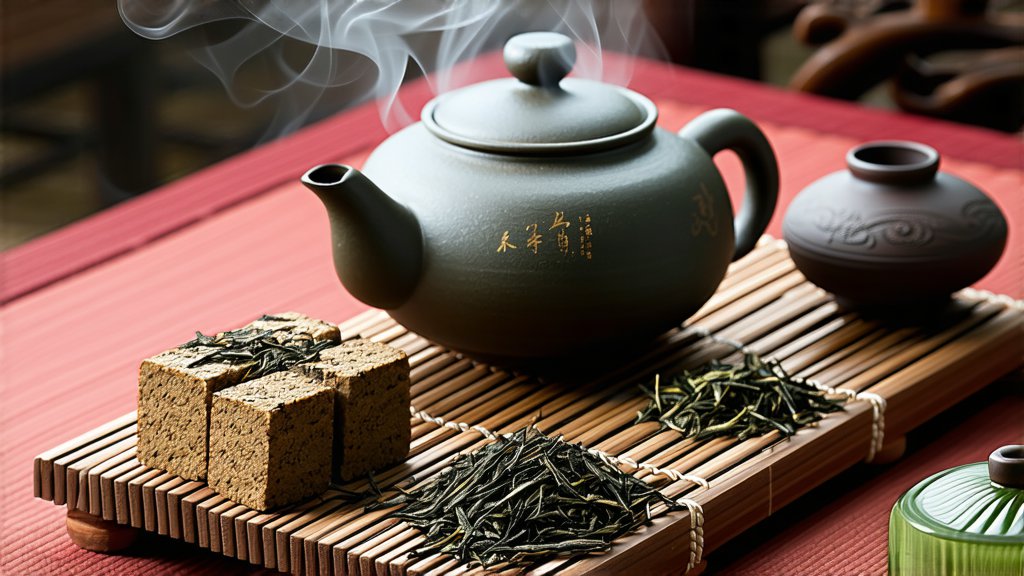
Pu-erh tea, a distinguished member of China's dark tea family, boasts a history that spans over a millennium, originating from the ancient tea-growing regions of Yunnan province. This unique tea has not only survived the test of time but has also evolved into a symbol of cultural heritage and sophistication in the world of tea.
Historical Background
The story of Pu-erh begins during the Tang Dynasty (618-907 AD) when tea was first pressed into cakes for easier transport along the Silk Road. However, it wasn't until the Ming Dynasty (1368-1644 AD) that Pu-erh tea started gaining recognition for its distinct post-fermentation aging process, which imparts complex flavors and aromas. By the Qing Dynasty (1644-1912 AD), Pu-erh had become a highly sought-after delicacy among the imperial court and aristocracy.
Varieties of Pu-erh Tea
Pu-erh tea is broadly categorized into two main types based on its processing method: Raw (Sheng) Pu-erh and Ripe (Shou) Pu-erh.
-
Raw (Sheng) Pu-erh: This type undergoes natural fermentation over time, with the aging process allowing microorganisms to interact with the tea leaves, resulting in a gradual transformation of taste and aroma. The flavor profile typically starts off more astringent and mellows into a smooth, earthy taste with hints of fruitiness and sweetness as it ages.
-
Ripe (Shou) Pu-erh: To expedite the aging process, Raw Pu-erh undergoes an additional fermentation step known as "wet piling," where piles of tea are kept moist and warm to accelerate microbial activity. This controlled fermentation gives Shou Pu-erh its distinctive deep reddish-brown color and a rich, mellow flavor with notes of wood, earth, and sometimes a subtle sweetness.
The Art of Making Pu-erh
The production of Pu-erh tea is a meticulous craft passed down through generations. It involves several stages:
-
Picking: Only the young leaves and buds are handpicked, ensuring the highest quality.
-
Withering: Freshly picked leaves are spread out to dry under the sun or indoors, reducing moisture content.
-
Fixation: The withered leaves are briefly heated to halt oxidation, preserving their greenish hue for Sheng Pu-erh or further processed for Shou.
-
Rolling & Shaping: Leaves are rolled into tight spirals or compressed into various shapes like cakes, bricks, or tuocha (nestled cakes).
-
Drying: The shaped tea is dried to remove excess moisture.
-
Fermentation: For Shou Pu-erh, the tea undergoes a specialized fermentation process in a controlled environment, while Sheng Pu-erh relies on natural aging and maturation.
Appreciating Pu-erh Tea
To truly savor the depths of Pu-erh tea, one must engage in a mindful tasting ritual:
-
Warm the Teapot: Rinse the teapot with hot water to prepare it for brewing.
-
Add Tea Leaves: Depending on personal preference, use approximately 5-8 grams of loose leaves or break off a piece of a tea cake.
-
First Infusion: Pour boiling water over the tea and let it steep for about 30 seconds to rinse the leaves. Discard this initial wash.
-
Subsequent Infusions: Subsequent steepings can range from 15 seconds to several minutes, gradually increasing the steeping time with each infusion to unlock different flavor profiles.
-
Observe & Sip: Admire the tea's color, inhale its aroma, and take small sips to fully appreciate its complexity and evolving taste.
Pu-erh tea offers not just a beverage but an experience that connects drinkers to centuries-old traditions and the natural world. Its health benefits, including aiding digestion, boosting metabolism, and promoting cardiovascular health, make it a cherished elixir worldwide. As you embark on your exploration of Pu-erh tea, remember that each cup tells a story—a narrative woven from the threads of history, culture, and nature's bounty.